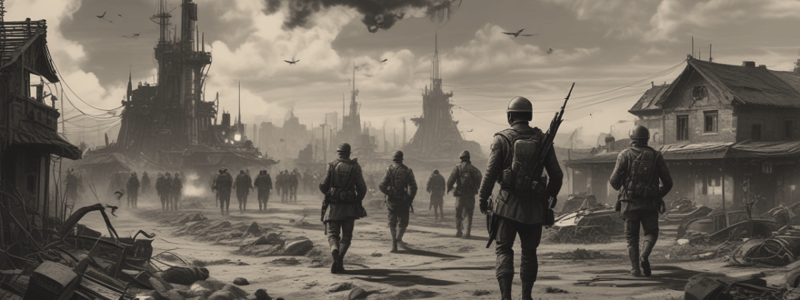Podcast
Questions and Answers
What was the immediate trigger for the outbreak of World War I?
What was the immediate trigger for the outbreak of World War I?
- The Battle of the Somme offensive
- The implementation of the Schlieffen Plan
- The assassination of Arch Duke Franz Ferdinand (correct)
- The invasion of Belgium
What was the main reason the Schlieffen Plan failed during World War I?
What was the main reason the Schlieffen Plan failed during World War I?
- The plan was too ambitious and complicated
- The Belgians put up stronger resistance than expected (correct)
- The Russians mobilized faster than expected
- The German army was outnumbered by the French army
What was the main purpose of the Battle of the Somme offensive during World War I?
What was the main purpose of the Battle of the Somme offensive during World War I?
- To break through the German lines and create a gap
- To distract the Germans from the Eastern Front
- To relieve pressure on the French army at Verdun (correct)
- To capture the city of Berlin
Who was widely blamed for the heavy losses during the Battle of the Somme?
Who was widely blamed for the heavy losses during the Battle of the Somme?
What was a characteristic of life in the trenches during World War I?
What was a characteristic of life in the trenches during World War I?
Flashcards are hidden until you start studying
Study Notes
Causes of WW1
- Long-term causes of WW1 include complex alliances, imperialism, nationalism, and militarism
- Assassination of Archduke Franz Ferdinand of Austria-Hungary on June 28, 1914, in Sarajevo, Bosnia, by Gavrilo Princip, a Bosnian Serb nationalist
Consequences of the Assassination
- Austria-Hungary issued an ultimatum to Serbia, which led to the declaration of war
- Russia mobilized its army in support of Serbia, prompting Germany to declare war on Russia and subsequently France
- Britain, bound by a treaty to defend Belgium, declared war on Germany after Germany invaded Belgium
The Schlieffen Plan
- The Schlieffen Plan was a German military strategy to avoid a two-front war by quickly defeating France and then focusing on Russia
- The plan failed due to Russian mobilization, French resistance, and British intervention
Life in the Trenches
- Soldiers in WW1 lived in trenches, which were dirty, cramped, and exposed to harsh weather conditions
- Trench warfare led to a stalemate, with soldiers on both sides dug in for years
The Battle of the Somme
- The Battle of the Somme was a disastrous British offensive on July 1, 1916, intended to relieve pressure on the French at Verdun
- The battle resulted in over 60,000 British casualties on the first day alone, with little territorial gain
Mistakes of the Battle of the Somme
- The British underestimated German defenses and overestimated the impact of artillery bombardment
- Insufficient reconnaissance, inadequate artillery support, and poor communication contributed to the disaster
- General Haig, the British commander, was criticized for his rigid tactics and failure to adapt to circumstances
General Haig and Responsibility
- General Douglas Haig was the British commander during the Battle of the Somme
- Haig was criticized for his role in the devastating losses during the battle, with some attributing the disaster to his strategic decisions
WW1 Weapons
- Weapons used in WW1 included machine guns, tanks, poison gas, and artillery
- Trench warfare led to the development of new technologies, such as flamethrowers and mortars
Studying That Suits You
Use AI to generate personalized quizzes and flashcards to suit your learning preferences.




